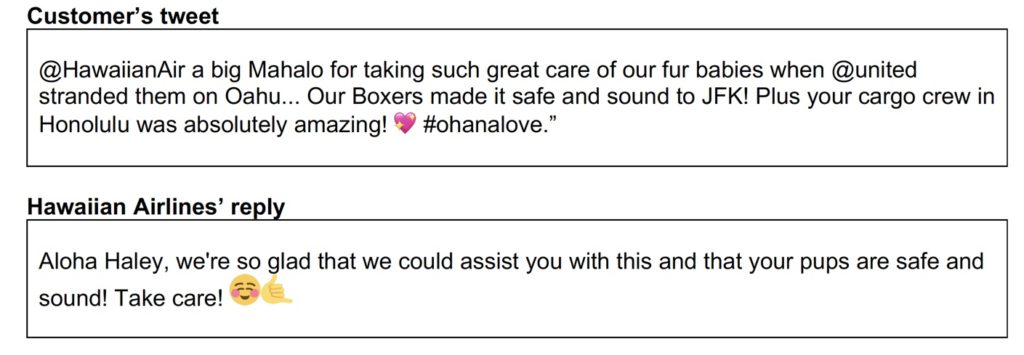 Wow. It's been a decade since companies began offering customer service via social media, and we certainly have improved over the years! We've shed outsized fears about being criticized by customers in public (gasp). We're using purpose-built tools to manage social customer care. And we're taking social customer care seriously by hiring professionals to oversee it who have a track record in these channels. Thankfully, we've stopped handing it off to Joe who's good at social because he's under 25. But there are still plenty of ways to improve the social media customer service we provide via Twitter, Facebook, and other channels. We must ensure that frontline agents who respond to customers in these channels have social-media-specific writing skills. While you may have staffed your social channels with experienced agents who know how to write great emails to customers or talk to them on the phone, writing to customers in social channels is challenging and different. Customer service agents need these three social-specific writing skills if they're going to deliver excellent customer care.
Wow. It's been a decade since companies began offering customer service via social media, and we certainly have improved over the years! We've shed outsized fears about being criticized by customers in public (gasp). We're using purpose-built tools to manage social customer care. And we're taking social customer care seriously by hiring professionals to oversee it who have a track record in these channels. Thankfully, we've stopped handing it off to Joe who's good at social because he's under 25. But there are still plenty of ways to improve the social media customer service we provide via Twitter, Facebook, and other channels. We must ensure that frontline agents who respond to customers in these channels have social-media-specific writing skills. While you may have staffed your social channels with experienced agents who know how to write great emails to customers or talk to them on the phone, writing to customers in social channels is challenging and different. Customer service agents need these three social-specific writing skills if they're going to deliver excellent customer care.
1. Write in your company's brand voice.
If your company's marketing is fun and friendly, but your customer service responses are scoldy or legalistic, that's not good. There shouldn't be a big disconnect between the voice your company uses with customers before they buy your product (marketing) and the voice you use when they need your help after they've bought your product (customer service). And it's even worse to make a brand voice blunder in a social channel because it's public. Here's a recent Twitter example from the grocery store chain Safeway. An unhappy customer tweeted, Yes, that's more than 30 people in line for the one open register @Safeway at 3350 Mission in San Francisco. #worstcustomerservice #Safeway, and paired his words with a photo of angry-looking people waiting in a very long line. Here's Safeway's reply: Thanks for making us aware of the inefficiency you encountered. The Store Director will be notified to focus on improving here. In addition to being dry and unempathetic, the writing style of this tweet is completely off. This writing doesn't sound like Safeway at all. And while Safeway is hardly an edgy or playful brand, the supermarket chain does use an upbeat, practical voice in its marketing, with phrases like Grill a Best Ever Juicy Burger and have the best summer ever or Just for U digital coupons make it easy to save¦ Safeway's social customer service agents should be trained to write in their company's brand voice because doing so builds rapport with customers and reduces repeat contacts. If they had this brand voice writing skill, their tweet might have been written like this: Oh no! I'm really sorry you had to wait. Thanks for letting us know. We shared your experience with the Store Directors, so they can prevent these long lines from happening in the future.
2. Explain why you want to move the discussion to a private channel.
There are lots of real-world customer service reasons to move from the public side of a social channel to the private side. You might have trained your social customer care agents to move to a direct message when:
- The customer is furious and riling everyone else up.
- They need the customer's account or order number, and don't want that info shared publicly.
- They need to ask troubleshooting questions before they can help the customer.
But it's not enough just to tell the customer, Let's move this to a DM. The agent needs to explain or imply why they want to make the discussion private. The USAA agent did this well in a recent exchange with an unhappy customer. The customer tweeted, 1sttime in almost 30 years @USAA disappoints over $200. Beware of #USAAcreditcards! #USAA #losingacustomer. For lots of reasons, USAA would want to move this discussion over to DM. Their social customer care agent agent crafted an excellent response, which makes it likely that the customer will discuss this issue privately. USAA tweeted:
Whoa, we certainly don't want you to feel this way. Can we have a look? Please DM your phone number, so we can locate your profile. Thanks.
The agent explains the reason for the DM and shows the intent to receive the customer's personal phone number privately. In contrast, here's an example of a @ComcastCares agent who needs more training on what to write when you want the customer to move the discussion to a private channel. The customer tweeted, Are there any trials for Showtime? We cancelled Starz due to lack of interest. Just wondering if we can have a trial for Showtime. And here's the @ComcastCares agent's reply:
We are happy to assist you. Can you please send us a DM? -BB.
That's just not good enough. Why does the customer need send a DM? Is there a trial for Showtime or not? Either answer the question publicly or explain why you want to make the conversation private.
3. Use emojis to sustain the feelings, not carry the facts, of your response.
Yes, we can and should use emojis in our social customer care responses. And yes, using emojis effectively is, in fact, a writing skill. Social customer care agents need to know to use concrete words for their responses to customers and use the more abstract or suggestive emojis to decorate or embellish their responses. It's not good customer service to use emojis to express the core of an answer to a customer. Here's an example of what not to do. A very worried customer sent this tweet to her mobile service provider, Help! I lost my phone! Can you track it and help me find it?

I am dying without my phone. And here's the response she received:
Yikes!

can help with locating your
 .
.
DM us your account info and your email address. We are here to help! Thanks, Barb

That tweet looks strange and is difficult to read. The customer, who is already distressed about the loss of her phone, may not be able to decipher it. The emojis get in the way. Here's Hawaiian Airlines' much better use of emojis in their response to a tweet from a customer who's thanking them for great service.
 Of course, it's easy to respond to happy tweets from happy customers. But Hawaiian has still demonstrated the best way to use emojis. The blushing emoji adds to the aw shucks feeling of the response, and the shaka sign is familiar, positive, and on-brand. And Hawaiian's tweet works just as well without the emojis as it does with them. It's great that the years have passed and we've all calmed down about social customer care. Most contact centers have integrated social channels into their operations and are going a good job of serving customers in these channels. And when we recognize that social customer care requires a special set of writing skills, we'll be able to move from providing good service to providing great, social-specific responses to our customers. This article originally appeared on the E-WRITE website. It is reprinted here with permission.
Of course, it's easy to respond to happy tweets from happy customers. But Hawaiian has still demonstrated the best way to use emojis. The blushing emoji adds to the aw shucks feeling of the response, and the shaka sign is familiar, positive, and on-brand. And Hawaiian's tweet works just as well without the emojis as it does with them. It's great that the years have passed and we've all calmed down about social customer care. Most contact centers have integrated social channels into their operations and are going a good job of serving customers in these channels. And when we recognize that social customer care requires a special set of writing skills, we'll be able to move from providing good service to providing great, social-specific responses to our customers. This article originally appeared on the E-WRITE website. It is reprinted here with permission.
Leslie O'FlahavanLeslie is a get-to-the point writer and an experienced, versatile writing instructor. As E-WRITE owner since 1996, Leslie has been writing content and teaching customized writing courses for Fortune 500 companies, government agencies, and nonprofit organizations. Leslie can help the most stubborn, inexperienced, or word-phobic employees at your organization improve their writing skills, so they can do their jobs better.